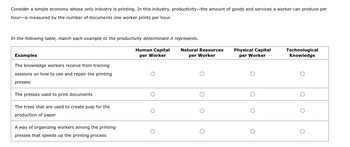
ENGR.ECONOMIC ANALYSIS
14th Edition
ISBN: 9780190931919
Author: NEWNAN
Publisher: Oxford University Press
expand_more
expand_more
format_list_bulleted
Concept explainers
Question
Consider a simple economy whose only industry is printing. In this industry, productivity—the amount of goods and services a worker can produce per hour—is measured by the number of documents one worker prints per hour.
In the following table, match each example to the productivity determinant it represents.
|
Examples
|
Human Capital per Worker
|
Natural Resources per Worker
|
Physical Capital per Worker
|
Technological Knowledge
|
|
|---|---|---|---|---|---|
| The knowledge workers receive from training sessions on how to use and repair the printing presses |
|
|
|
|
|
| The presses used to print documents |
|
|
|
|
|
| The trees that are used to create pulp for the production of paper |
|
|
|
|
|
| A way of organizing workers among the printing presses that speeds up the printing process |
|
|
|
|

Transcribed Image Text:Consider a simple economy whose only industry is printing. In this industry, productivity—the amount of goods and services a worker can produce per hour—is measured by the number of documents one worker prints per hour.
**In the following table, match each example to the productivity determinant it represents.**
| Examples | Human Capital per Worker | Natural Resources per Worker | Physical Capital per Worker | Technological Knowledge |
|--------------------------------------------------------------------------|--------------------------|------------------------------|-----------------------------|-------------------------|
| The knowledge workers receive from training sessions on how to use and repair the printing presses | ⭘ | | | |
| The presses used to print documents | | | ⭘ | |
| The trees that are used to create pulp for the production of paper | | ⭘ | | |
| A way of organizing workers among the printing presses that speeds up the printing process | | | | ⭘ |
Expert Solution
This question has been solved!
Explore an expertly crafted, step-by-step solution for a thorough understanding of key concepts.
This is a popular solution
Trending nowThis is a popular solution!
Step by stepSolved in 2 steps

Knowledge Booster
Learn more about
Need a deep-dive on the concept behind this application? Look no further. Learn more about this topic, economics and related others by exploring similar questions and additional content below.Similar questions
- Solve all this question compulsory....arrow_forwardRefer to Ch. 6, Fig. 6.2 (The Effect of Technological Improvement) and Example 6.2 (Malthus and the Food Crisis) Malthus believed that the world's limited amount of land would not be able to supply enough food as the population grew. As a result there would be mass hunger and starvation. But Malthus was proved wrong! Explain why Malthus' prediction about mass hunger and starvation did not come to pass.arrow_forwardPlease answer the following questions and carefully label , and briefly explain the following diagrams. You are welcome to write any accompanying text by hand. 5. Show how the diagram changes if there is an improvement in the technology of food production.Hint: this means that for a given number of hours’ work, Angela can produce more. 5.2. If Angela is an independent farmer, show how the technology improvement might cause heroptimal labour supply to either fall or rise. Which seems more consistent with the data?arrow_forward
Recommended textbooks for you

 Principles of Economics (12th Edition)EconomicsISBN:9780134078779Author:Karl E. Case, Ray C. Fair, Sharon E. OsterPublisher:PEARSON
Principles of Economics (12th Edition)EconomicsISBN:9780134078779Author:Karl E. Case, Ray C. Fair, Sharon E. OsterPublisher:PEARSON Engineering Economy (17th Edition)EconomicsISBN:9780134870069Author:William G. Sullivan, Elin M. Wicks, C. Patrick KoellingPublisher:PEARSON
Engineering Economy (17th Edition)EconomicsISBN:9780134870069Author:William G. Sullivan, Elin M. Wicks, C. Patrick KoellingPublisher:PEARSON Principles of Economics (MindTap Course List)EconomicsISBN:9781305585126Author:N. Gregory MankiwPublisher:Cengage Learning
Principles of Economics (MindTap Course List)EconomicsISBN:9781305585126Author:N. Gregory MankiwPublisher:Cengage Learning Managerial Economics: A Problem Solving ApproachEconomicsISBN:9781337106665Author:Luke M. Froeb, Brian T. McCann, Michael R. Ward, Mike ShorPublisher:Cengage Learning
Managerial Economics: A Problem Solving ApproachEconomicsISBN:9781337106665Author:Luke M. Froeb, Brian T. McCann, Michael R. Ward, Mike ShorPublisher:Cengage Learning Managerial Economics & Business Strategy (Mcgraw-...EconomicsISBN:9781259290619Author:Michael Baye, Jeff PrincePublisher:McGraw-Hill Education
Managerial Economics & Business Strategy (Mcgraw-...EconomicsISBN:9781259290619Author:Michael Baye, Jeff PrincePublisher:McGraw-Hill Education


Principles of Economics (12th Edition)
Economics
ISBN:9780134078779
Author:Karl E. Case, Ray C. Fair, Sharon E. Oster
Publisher:PEARSON

Engineering Economy (17th Edition)
Economics
ISBN:9780134870069
Author:William G. Sullivan, Elin M. Wicks, C. Patrick Koelling
Publisher:PEARSON

Principles of Economics (MindTap Course List)
Economics
ISBN:9781305585126
Author:N. Gregory Mankiw
Publisher:Cengage Learning

Managerial Economics: A Problem Solving Approach
Economics
ISBN:9781337106665
Author:Luke M. Froeb, Brian T. McCann, Michael R. Ward, Mike Shor
Publisher:Cengage Learning

Managerial Economics & Business Strategy (Mcgraw-...
Economics
ISBN:9781259290619
Author:Michael Baye, Jeff Prince
Publisher:McGraw-Hill Education